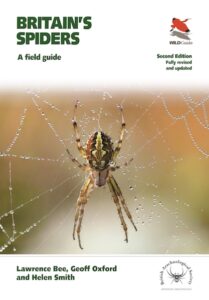 When our daughter was still very young, Mrs. Naturalist and I made a concerted effort to do all we could to prevent the little one from growing up with a fear of spiders. While I don’t dispute that there do exist cases of genuine arachnophobia (an example of which I unexpectedly discovered in a colleague with whom I was traveling on business some years ago), I am of the opinion that the negative feelings about, and reactions to, spiders too-commonly still witnessed today are much more so socially instilled than pathological. I’m very pleased to say that it worked; not only is she not afraid of them, when one is found in an inconvenient place in the house she picks it up and moves it somewhere out of harm’s way, speaking friendly words of comfort to it all the while.
When our daughter was still very young, Mrs. Naturalist and I made a concerted effort to do all we could to prevent the little one from growing up with a fear of spiders. While I don’t dispute that there do exist cases of genuine arachnophobia (an example of which I unexpectedly discovered in a colleague with whom I was traveling on business some years ago), I am of the opinion that the negative feelings about, and reactions to, spiders too-commonly still witnessed today are much more so socially instilled than pathological. I’m very pleased to say that it worked; not only is she not afraid of them, when one is found in an inconvenient place in the house she picks it up and moves it somewhere out of harm’s way, speaking friendly words of comfort to it all the while.
It’s simply a matter of understanding – fear often comes from ignorance, and the best antidote to ignorance is knowledge. And when it comes to acquiring a knowledge of spiders – at least those of Great Britain – it’s dashedly to find a more informative and accessible book about them than Britain’s Spiders from the Princeton University Press WILDGuides series.
Originally published to noteworthy acclaim in 2017, it has now been fully revised and updated into a second edition by the authorial team of Lawrence Bee, Geoff Oxford, and Helen Smith. Focusing on the species across all thirty-eight of Great Britain’s taxonomic families of spiders that can most readily be identified in the field, this new edition includes nine species that are new to Britain, as well as updated information on all previously included species, fresh distribution maps, new identification guides to spider families and distinctive species, and the latest spider species checklist.
That this is a superb field guide for any naturalist going afield in Great Britain should go without saying; however I hope it will be taken up well beyond the expected natural history circles. Whether we always know it or not, we all encounter quite a number of different spiders each and every day. Learning to recognize them in all their wondrous variety and coming to understand a bit about their lives and habits is vital not only to becoming a more aware and responsible resident of the planet, it is also a superb way to overcome any fears that may have been unfortunately picked up somewhere along life’s journey. For all those in Great Britain – and indeed, while the species won’t match, the general information in the book about arachnid lives and behavior are useful regardless of geographic location – this new second edition of Britain’s Spiders is a book well worth having on hand.
Available from:

